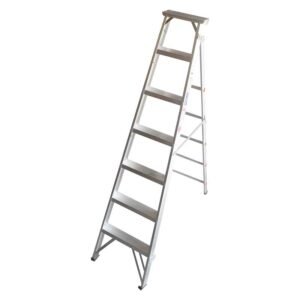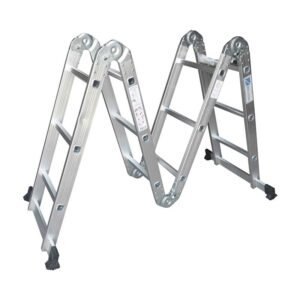When it comes to using ladders, safety should always be a top priority. Whether you’re using a ladder for work or a DIY project at home, understanding proper usage and maintenance is essential. In this article, we will provide you with valuable tips on how to stay safe on ladders. Using the right ladder for the job is crucial. Make sure to choose the appropriate ladder height and weight capacity to avoid accidents. Additionally, inspect your ladder before each use. Check for any signs of damage, such as cracks or loose screws. It’s also important to set up your ladder on a flat and stable surface, away from any electrical hazards. Proper ladder usage is another critical aspect of ladder safety. Always maintain three points of contact with the ladder – two hands and one foot, or two feet and one hand. Avoid leaning or overreaching while on the ladder, as this can lead to loss of balance. Regular ladder maintenance is essential for your safety. Keep your ladder clean and free from debris that could cause slipping. Store it properly in a dry location to prevent rust or corrosion. By following these tips, you can ensure a safe and secure ladder experience. Stay tuned for more useful information on ladder safety in the rest of this article.
Importance of Ladder Safety
Ladders are essential tools for many tasks, whether at home or at work. They allow us to reach higher places, access roofs, paint walls, install lights, and more. However, ladders also pose significant risks if not used properly. According to the World Health Organization, falls from height are the second leading cause of unintentional injury deaths worldwide, and ladders are involved in many of these incidents. Therefore, it is crucial to follow ladder safety guidelines and best practices to prevent accidents and injuries.
Common Accidents and Injuries Associated with Ladder Use
Some of the most common accidents and injuries that occur due to ladder use are:
- Falling from the ladder, either due to losing balance, slipping, or the ladder collapsing or tipping over. This can result in fractures, sprains, head injuries, spinal cord injuries, or even death.
- Striking or being struck by objects, such as tools, materials, or overhead wires. This can cause cuts, bruises, burns, electrocution, or eye injuries.
- Overexertion or fatigue, such as from carrying heavy loads, working in awkward positions, or climbing too fast. This can lead to muscle strains, cramps, dehydration, or heat stroke.
Choosing the Right Ladder for Your Needs
get it now
To ensure ladder safety, it is important to choose the right ladder for your needs. There are different types of ladders, such as step ladders, extension ladders, platform ladders, and multi-purpose ladders, each with their own advantages and disadvantages. Some factors to consider when choosing a ladder are:
- The height and reach you need. The ladder should be long enough to reach your work area without standing on the top rung or step. The rule of thumb is to have at least three feet of ladder above the highest point of contact.
- The weight capacity and duty rating. The ladder should be able to support your weight and the weight of any tools or materials you are using. The duty rating indicates the maximum load that the ladder can safely carry, and it ranges from light duty (200 lbs) to extra heavy duty (375 lbs).
- The material and construction. The ladder should be made of durable and sturdy material, such as wood, metal, or fiberglass. The material should also be suitable for the environment and conditions you are working in, such as indoors or outdoors, wet or dry, hot or cold, etc.
- The features and accessories. The ladder should have features and accessories that enhance its safety and functionality, such as non-slip feet, locking mechanisms, stabilizers, levelers, hooks, trays, etc.
Types of Ladders Shabbir Enterprise offers for your needs
Aluminum Ladders
Aluminum Ladder Double Side Step
GET IT NOW
Aluminum Ladder Dual Purpose
GET IT NOW
Fibreglass Ladders
Preparing for Ladder Use – Checking for Stability and Ensuring Proper Setup
Before using a ladder, it is essential to check for its stability and ensure proper setup. Some steps to follow are:
- Inspect the ladder for any damage, defects, or wear and tear, such as cracks, dents, loose or missing parts, etc. If the ladder is damaged, do not use it and report it to your supervisor or manager.
- Choose a level and firm surface to place the ladder. Avoid placing the ladder on slippery, uneven, or soft ground, such as mud, sand, or grass. If the surface is not level, use a ladder leveler or wedge to adjust the ladder’s angle.
- Set up the ladder at the correct angle and distance from the wall or structure. For extension ladders, the angle should be about 75 degrees, and the distance should be one-fourth of the ladder’s length. For step ladders, the angle should be 90 degrees, and the ladder should be fully opened and locked.
- Secure the ladder to prevent it from moving, sliding, or falling. For extension ladders, use ropes, straps, or hooks to tie the ladder to a fixed point, such as a window, a beam, or a railing. For step ladders, use a stabilizer or a spreader bar to prevent the ladder from folding or collapsing.
Proper Ladder Usage Techniques – Climbing, Descending, and Maintaining Balance
Once the ladder is stable and properly set up, it is important to use proper ladder usage techniques to climb, descend, and maintain balance. Some tips to follow are:
- Wear appropriate clothing and footwear. Avoid wearing loose, baggy, or dangling clothing that could get caught on the ladder or the surroundings. Wear shoes that have good traction and fit well, such as boots or sneakers. Avoid wearing sandals, slippers, or heels.
- Carry only what you need and use a tool belt or a bucket. Avoid carrying too much weight or bulky items that could affect your balance or obstruct your vision. Use a tool belt or a bucket to hold your tools and materials, and attach them to the ladder or a nearby point.
- Climb and descend slowly and carefully. Use both hands to grip the ladder’s rungs or rails, and face the ladder at all times. Do not skip or jump from one rung or step to another. Do not climb or descend faster than you can safely control.
- Maintain a good posture and balance. Keep your body centered and aligned with the ladder, and do not lean or reach too far to the sides or the front. Keep your shoulders within the ladder’s rails, and your belt buckle within the ladder’s rungs. Maintain three points of contact with the ladder at all times, such as two hands and one foot, or two feet and one hand.
Safety Precautions While on a Ladder – Avoiding Overreaching, Using Proper Footwear, and Maintaining Three Points of Contact
While on a ladder, it is vital to follow safety precautions to avoid accidents and injuries. Some of the most important precautions are:
- Avoid overreaching. Do not extend your arms or legs beyond your comfortable reach, as this could cause you to lose balance or tip the ladder over. If you need to access a different area, climb down and move the ladder closer to your work spot.
- Use proper footwear. Wear shoes that have good traction and fit well, such as boots or sneakers. Avoid wearing sandals, slippers, or heels, as they could slip or get stuck on the ladder’s rungs or steps. Also, make sure your shoes are clean and dry, and free of any dirt, mud, oil, or grease that could make them slippery.
- Maintain three points of contact. Keep three points of contact with the ladder at all times, such as two hands and one foot, or two feet and one hand. This helps you to maintain stability and balance, and reduces the risk of falling. Do not let go of the ladder or stand on one foot, as this could make you unstable or unsteady.
Maintaining and Inspecting Your Ladder for Wear and Tear
To ensure ladder safety, it is also important to maintain and inspect your ladder for wear and tear. Some steps to follow are:
- Clean your ladder regularly. Remove any dirt, dust, debris, or residue that could affect the ladder’s performance or safety, such as mud, sand, oil, grease, paint, etc. Use a damp cloth or a soft brush to wipe or scrub the ladder, and dry it thoroughly before storing or using it.
- Lubricate your ladder’s moving parts. Apply a thin layer of oil or grease to the ladder’s hinges, locks, pulleys, ropes, or springs, to prevent them from rusting, corroding, or jamming. Do not use too much oil or grease, as this could make the ladder slippery or attract dirt.
- Repair or replace your ladder’s damaged parts. If you notice any damage, defects, or wear and tear on your ladder, such as cracks, dents, loose or missing parts, etc., do not use the ladder and report it to your supervisor or manager. If possible, repair or replace the damaged parts, or dispose of the ladder safely and get a new one.
Storing and Transporting Ladders Safely
Another aspect of ladder safety is storing and transporting ladders safely. Some tips to follow are:
- Store your ladder in a dry and secure place. Avoid exposing your ladder to moisture, sunlight, heat, or cold, as these could damage the ladder’s material or structure. Store your ladder in a dry and secure place, such as a shed, a garage, or a closet, and lock it if possible. Do not store your ladder near any sources of fire, electricity, or chemicals, as these could cause a fire or an explosion.
- Transport your ladder carefully and securely. When transporting your ladder, use a vehicle that can accommodate the ladder’s size and weight, such as a truck, a van, or a trailer. Secure the ladder to the vehicle with ropes, straps, or hooks, and make sure it does not extend beyond the vehicle’s length or width. If the ladder does extend beyond the vehicle, use a red flag or a light to indicate its presence. Do not transport your ladder with any passengers, tools, or materials on it, as this could cause injury or damage.
Additional Safety Tips for Specific Ladder Types – Extension Ladders, Step Ladders, and Platform Ladders
Different types of ladders have different features and functions, and therefore require different safety tips. Here are some additional safety tips for specific ladder types:
- Extension ladders. These are ladders that can be extended or retracted to adjust their length. They are usually used for reaching high places, such as roofs, trees, or windows. Some additional safety tips for extension ladders are:
- Do not exceed the maximum length or height of the ladder, as this could make it unstable or weak.
Ready to experience the strength, durability, and versatility of high-quality Ladder duty needs? Choose Shabbir Enterprise for a reliable solution that meets industry standards. Don’t compromise on safety and efficiency – get in touch with us now and elevate your Ladders operations to new heights!
















